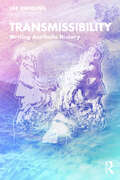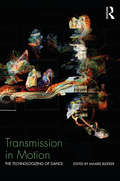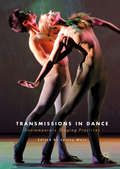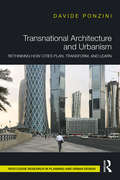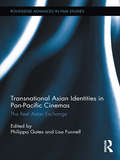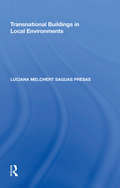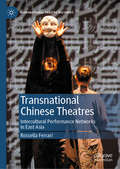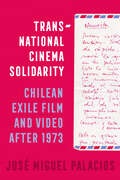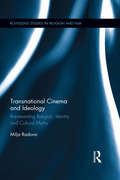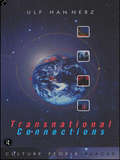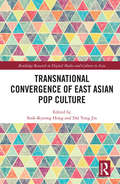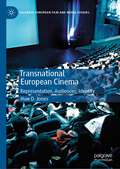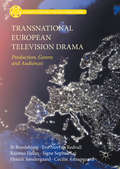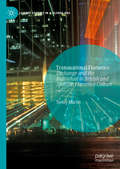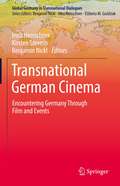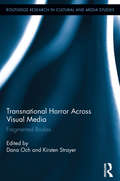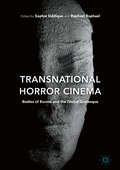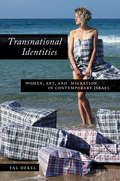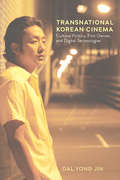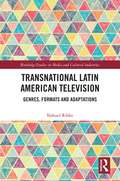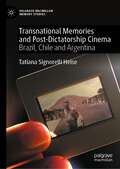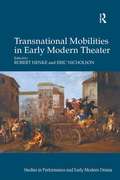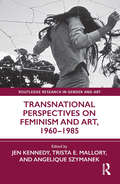- Table View
- List View
Transmissibility: Writing Aesthetic History
by Jae EmerlingThis book examines transmissibility to remind us why the vitality and epistemic significance of an artwork is anachronistic and futural. Transmissibility: Writing Aesthetic History performs a transdisciplinary philosophy of aesthetic history via the work of Gilles Deleuze and Félix Guattari, Cy Twombly, Marina Abramović, Paul Celan, Cecil Taylor, Italo Calvino, Candida Höfer, and others by focusing on theartistic and historiographic labor that differentiates artworks from other modes of creation.
Transmission in Motion: The Technologizing of Dance
by Maaike BleekerHow can various technologies, from the more conventional to the very new, be used to archive, share and understand dance movement? How can they become part of new ways of creating dance? What does this tell us about the ways in which technology is part of how we make sense and think? Well-known choreographers and dance collectives including William Forsythe, Siohban Davis, Merce Cunningham, Anne Teresa De Keersmaeker and BADco. have initiated projects to investigate these questions, and in so doing have inaugurated a new era for dance archives, education, research and creation. Their work draws attention to the intimate relationship between the technologies we use and the ways in which we think, perceive, and make sense. Transmission in Motion examines these extraordinary projects ‘from the inside’, presenting in-depth analyses by the practitioners, artists and collectives involved in their development. These studies are framed by scholarly reflection, illuminating the significance of these projects in the context of current debates on dance, the (multi-media) archive, immaterial cultural heritage and copyright, embodied cognition, education, media culture and the knowledge society.
Transmissions in Dance
by Lesley MainThis book is a collection of essays that capture the artistic voices at play during a staging process. Situating familiar practices such as reimagining, reenactment and recreation alongside the related and often intersecting processes of transmission, translation and transformation, it features deep insights into selected dances from directors, performers, and close associates of choreographers. The breadth of practice on offer illustrates the capacity of dance as a medium to adapt successfully to diverse approaches and, further, that there is a growing appetite amongst audiences for seeing dances from the near and far past. This study spans a century, from Rudolf Laban's Dancing Drumstick (1913) to Robert Cohan's Sigh (2015), and examines works by Mary Wigman, Madge Atkinson (Natural Movement), Doris Humphrey, Martha Graham, Yvonne Rainer and Rosemary Butcher, an eclectic mix that crosses time and borders.
Transnational Architecture and Urbanism: Rethinking How Cities Plan, Transform, and Learn
by Davide PonziniTransnational Architecture and Urbanism combines urban planning, design, policy, and geography studies to offer place-based and project-oriented insight into relevant case studies of urban transformation in Europe, North America, Asia, and the Middle East. Since the 1990s, increasingly multinational modes of design have arisen, especially concerning prominent buildings and places. Traditional planning and design disciplines have proven to have limited comprehension of, and little grip on, such transformations. Public and scholarly discussions argue that these projects and transformations derive from socioeconomic, political, cultural trends or conditions of globalization. The author suggests that general urban theories are relevant as background, but of limited efficacy when dealing with such context-bound projects and policies. This book critically investigates emerging problematic issues such as the spectacularization of the urban environment, the decontextualization of design practice, and the global circulation of plans and projects. The book portends new conceptualizations, evidence-based explanations, and practical understanding for architects, planners, and policy makers to critically learn from practice, to cope with these transnational issues, and to put better planning in place.
Transnational Asian Identities in Pan-Pacific Cinemas: The Reel Asian Exchange (Routledge Advances in Film Studies)
by Lisa Funnell Philippa GatesThis collection examines the exchange of Asian identities taking place at the levels of both film production and film reception amongst pan-Pacific cinemas. The authors consider, on the one hand, texts that exhibit what Mette Hjort refers to as, "marked transnationality," and on the other, the polysemic nature of transnational film texts by examining the release and reception of these films. The topics explored in this collection include the innovation of Hollywood generic formulas into 1950's and 1960's Hong Kong and Japanese films; the examination of Thai and Japanese raced and gendered identity in Asian and American films; the reception of Hollywood films in pre-1949 China and millennial Japan; the production and performance of Asian adoptee identity and subjectivity; the political implications and interpretations of migrating Chinese female stars; and the production and reception of pan-Pacific co-productions..
Transnational Buildings in Local Environments (Design And The Built Environment Ser.)
by Luciana Melchert PresasBy focusing on the skyscraping transnational building, this book bridges two key debates on the transformation and emerging problems besetting major cities - globalization and ecological and sustainable building design. While such structures tend to be constructed and/or used by transnational companies and are generally viewed as emblems of a 'global city', they nevertheless impact seriously on their local environment, posing numerous environmental burdens on it. By examining office blocks held by multinational firms in Amsterdam, São Paolo and Beijing, the book analyses how transnational buildings might be made sustainable. It compares and contrasts the different social mechanisms that are, or may be, in place and how sustainable building practices that are being activated in certain locations could be adopted elsewhere.
Transnational Chinese Theatres: Intercultural Performance Networks in East Asia (Transnational Theatre Histories)
by Rossella FerrariThis is the first systematic study of networks of performance collaboration in the contemporary Chinese-speaking world and of their interactions with the artistic communities of the wider East Asian region. It investigates the aesthetics and politics of collaboration to propose a new transnational model for the analysis of Sinophone theatre cultures and to foreground the mobility and relationality of intercultural performance in East Asia. The research draws on extensive fieldwork, interviews with practitioners, and direct observation of performances, rehearsals, and festivals in Asia and Europe. It offers provocative close readings and discourse analysis of an extensive corpus of hitherto untapped sources, including unreleased video materials and unpublished scripts, production notes, and archival documentation.
Transnational Cinema Solidarity: Chilean Exile Film and Video after 1973 (Cinema Cultures in Contact)
by José Miguel PalaciosAfter the 1973 coup that put an end to the socialist government of Salvador Allende, most Chilean filmmakers went into exile. Dispersed all over the world, they made more than two hundred fiction films, documentaries, animations, videos, and works for television. José Miguel Palacios builds upon extensive archival research to trace a transnational history of this radical cinema, beginning with its emergence out of global solidarity networks in the 1970s. Chronicling the dangerous efforts to smuggle film reels out of Chile, the discourses of political cinema these films inspired as they traveled between film festivals, and the prints’ unfinished process of return to Chilean archives and museums over the past two decades, Transnational Cinema Solidarity offers a politicized understanding of world and transnational cinema that emphasizes geopolitical relations and cinematic alliances based on solidarity.
Transnational Cinema and Ideology: Representing Religion, Identity and Cultural Myths (Routledge Studies in Religion and Film)
by Milja RadovicIncreasingly, as the production, distribution and audience of films cross national boundaries, film scholars have begun to think in terms of ‘transnational’ rather than national cinema. This book is positioned within the emerging field of transnational cinema, and offers a groundbreaking study of the relationship between transnational cinema and ideology. The book focuses in particular on the complex ways in which religion, identity and cultural myths interact in specific cinematic representations of ideology. Author Milja Radovic approaches the selected films as national, regional products, and then moves on to comparative analysis and discussion of their transnational aspects. This book also addresses the question of whether transnationalism reinforces the nation or not; one of the possible answers to this question may be given through the exploration of the cinema of national states and its transnational aspects. Radovic illustrates the ways in which these issues, represented and framed by films, are transmitted beyond their nation-state borders and local ideologies in which they originated – and questions whether therefore one can have an understanding of transnational cinema as a platform for political dialogue.
Transnational Connections: Culture, People, Places (Comedia)
by Ulf HannerzThis work provides an account of culture in an age of globalization. Ulf Hannerz argues that, in an ever-more interconnected world, national understandings of culture have become insufficient. He explores the implications of boundary-crossings and long-distance cultural flows for established notions of "the local", "community", "nation" and "modernity" Hannerz not only engages with theoretical debates about culture and globalization but raises issues of how we think and live today. His account of the experience of global culture encompasses a shouting match in a New York street about Salman Rushdie, a papal visit to the Maya Indians; kung-fu dancers in Nigeria and Rastafarians in Amsterdam; the nostalgia of foreign correspondents; and the surprising experiences of tourists in a world city or on a Borneo photo safari.
Transnational Convergence of East Asian Pop Culture (Routledge Research in Digital Media and Culture in Asia)
by Dal Yong Jin Seok-Kyeong HongThis book observes and analyses transnational interactions of East Asian pop culture and current cultural practices, comparing them to the production and consumption of Western popular culture and providing a theoretical discussion regarding the specific paradigm of East Asian pop culture. Drawing on innovative theoretical perspectives and grounded empirical research, an international team of authors consider the history of transnational flows within pop culture and then systematically address pop culture itself, digital technologies, and the media industry. Chapters cover the Hallyu – or Korean Wave – phenomenon, as well as Japanese and Chinese cultural industries. Throughout the book, the authors address the convergence of the once-separated practical, industrial, and business aspects of popular culture under the influence of digital culture. They further coherently synthesize a vast collection of research to examine the specific realities and practices of consumers that exist beyond regional boundaries, shared cultural identities, and historical constructs. This book will be of interest to academic researchers, undergraduates, and graduate students studying Asian media, media studies, communication studies, cultural studies, transcultural communication, or sociology.
Transnational European Cinema: Representation, Audiences, Identity (Palgrave European Film and Media Studies)
by Huw D. JonesThis book explores how audiences in contemporary Europe engage with films from other European countries. It draws on admissions data, surveys, and focus group discussions from across the continent to explain why viewers are attracted to particular European films, nationalities, and genres, including action-adventures, family films, animations, biopics, period dramas, thrillers, comedies, contemporary drama, and romance. It also examines how these films are financed, produced, and distributed, how they represent Europe and other Europeans, and how they affect audiences. Case-studies range from mainstream movies like Skyfall, Taken, Asterix & Obelix: God Save Britannia, and Sammy’s Adventures: A Turtle’s Tale to more middlebrow and arthouse titles, such as The Lives of Others, Volver, Coco Before Chanel, The Girl with the Dragon Tattoo, Intouchables, The Angels’ Share, Ida, The Hunt, and Blue Is the Warmest Colour. The study shows that watching European films can sometimes improve people’s understandings of other countries and make them feel more European. However, this is limited by the strong preference for Anglo-American action-adventures that offer few insights into the realities of European life. While some popular European arthouse films explore a wider range of nationalities, social issues, and historical events, these mainly appeal to urban-dwelling graduates. They can also sometimes accentuate tensions between Europeans instead of bringing them together. The book discusses what these findings mean for the European film industry, audiovisual policy, and scholarship on transnational and European cinema. It also considers how surveys, focus groups, databases and other methods that go beyond traditional textual analysis can offer new insights into our understanding of film.
Transnational European Television Drama
by Eva Novrup Redvall Ib Bondebjerg Rasmus Helles Signe Sophus Lai Henrik Søndergaard Cecilie AstrupgaardThis book deals with the role of television drama in Europe as enabler of transnational, cultural encounters for audiences and the creative community. It demonstrates that the diversity of national cultures is a challenge for European TV drama but also a potential richness and source of creative variation. Based on data on the production, distribution and reception of recent TV drama from several European countries, the book presents a new picture of the transnational European television culture. The authors analyse main tendencies in television policy and challenges for national broadcasters coming from new global streaming services. Comparing cases of historical, contemporary and crime drama from several countries, this study shows the importance of creative co-production and transnational mediated cultural encounters between national cultures of Europe.
Transnational Flamenco: Exchange and the Individual in British and Spanish Flamenco Culture (Leisure Studies in a Global Era)
by Tenley MartinThis book provides insight into how flamenco travels, the forms it assumes in new locales, and the reciprocal effects on the original scene. Utilising a postnational approach to cultural identity, Martin explores the role of non-native culture brokers in cultural transmission. This concept, referred to as ‘cosmopolitan human hubs’, builds on Kiwan and Meinhof’s ‘hubs’ theory of network migration to move cultural migration and globalisation studies forwards. Martin outlines a post-globalisation flamenco culture through analysis of ethnographic research carried out in the UK, Sevilla and Madrid. Insight into these glocal scenes characterises flamenco as a historically globalized art complex, represented in various hubs around the world. This alternative approach to music migration and globalisation studies will be of interest to students and scholars across leisure studies, musicology, sociology and anthropology.
Transnational German Cinema: Encountering Germany Through Film and Events (Global Germany in Transnational Dialogues)
by Kirsten Stevens Benjamin Nickl Irina HerrschnerThis volume explores the notion of German cinema as both a national and increasingly transnational entity. It brings together chapters that analyse the international circuits of development and distribution that shape the emerging films as part of a contemporary “German cinema”, the events and spectacles that help frame and re-frame national cinemas and their discoverability, and the well-known filmmakers who sit at the vanguard of the contemporary canon. Thereby, it explores what we understand as German cinema today and the many points where this idea of national cinema can be interrogated, expanded and opened up to new readings. At the heart of this interrogation is a keen awareness of the technological, social, economic and cultural changes that have an impact on global cinemas more broadly: new distribution channels such as streaming platforms and online film festivals, and audience engagement that transcends national borders as well as the cinema space. International film production and financing further heightens the transnational aspects of cinema, a quality that is often neglected in marketing and branding of the filmic product. With particular focus on film festivals, this volume explores the tensions between the national and transnational in film, but also in the events that sit at the heart of global cinema culture. It includes contributions from filmmakers, cultural managers and other professionals in the field of film and cinema, as well as scholarly contributions from academics researching popular culture, film, and events in relation to Germany.
Transnational Horror Across Visual Media: Fragmented Bodies (Routledge Research in Cultural and Media Studies #55)
by Dana Och Kirsten StrayerThis volume investigates the horror genre across national boundaries (including locations such as Africa, Turkey, and post-Soviet Russia) and different media forms, illustrating the ways that horror can be theorized through the circulation, reception, and production of transnational media texts. Perhaps more than any other genre, horror is characterized by its ability to be simultaneously aware of the local while able to permeate national boundaries, to function on both regional and international registers. The essays here explore political models and allegories, questions of cult or subcultural media and their distribution practices, the relationship between regional or cultural networks, and the legibility of international horror iconography across distinct media. The book underscores how a discussion of contemporary international horror is not only about genre but about how genre can inform theories of visual cultures and the increasing permeability of their borders.
Transnational Horror Cinema
by Sophia Siddique Raphael RaphaelThis book broadens the frameworks by which horror is generally addressed. Rather than being constrained by psychoanalytical models of repression and castration, the volume embraces M. M. Bakhtin's theory of the grotesque body. For Bakhtin, the grotesque body is always a political body, one that exceeds the boundaries and borders that seek to contain it, to make it behave and conform. This vital theoretical intervention allows Transnational Horror Cinema to widen its scope to the social and cultural work of these global bodies of excess and the economy of their grotesque exchanges. With this in mind, the authors consider these bodies' potentials to explore and perhaps to explode rigid cultural scripts of embodiment, including gender, race, and ability.
Transnational Horror Cinema: Bodies of Excess and the Global Grotesque
by Sophia Siddique and Raphael RaphaelThis book broadens the frameworks by which horror is generally addressed. Rather than being constrained by psychoanalytical models of repression and castration, the volume embraces M.M. Bakhtin’s theory of the grotesque body. For Bakhtin, the grotesque body is always a political body, one that exceeds the boundaries and borders that seek to contain it, to make it behave and conform. This vital theoretical intervention allows Transnational Horror Cinema to widen its scope to the social and cultural work of these global bodies of excess and the economy of their grotesque exchanges. With this in mind, the authors consider these bodies’ potentials to explore and perhaps to explode rigid cultural scripts of embodiment, including gender, race, and ability.
Transnational Identities: Women, Art, and Migration in Contemporary Israel
by Tal DekelTranslated originally from Hebrew, Transnational Identities: Women, Art, and Migration in Contemporary Israel offers a critical discussion of women immigrants in Israel through an analysis of works by artists who immigrated to the country beginning in the 1990s. Though numerous aspects of the issue of women migrants have received intense academic scrutiny, no scholarly books to date have addressed the gender facets of the experiences of contemporary women immigrants in Israel. The book follows an up-to-date theoretical model, adopting critical tools from a wide range of fields and weaving them together through an in-depth qualitative study that includes the use of open interviews, critical theories, and analysis of artworks, offering a unique and compelling perspective from which to discuss this complex subject of citizenship and cultural belonging in an ethno-national state. It therefore stands to make a significant contribution to research into women's lives, citizenship studies, global migration, Jewish and national identity and women's art in contemporary Israel. The book is divided into sections, each of which aims a spotlight on women artists belonging to a distinct groups of immigrants—the former Soviet Union, Ethiopia, and the Philippines—and shows how their artwork reflects various conflicts regarding citizenship and identity-related processes, dynamics of inclusion-exclusion, and power relations that characterize their experiences. Transnational Identities promotes a more nuanced, complex understanding of diversity among women from various groups and even within a specific ethnic group, as well as considering the "common differences" between women from diversified life experiences. To lay the groundwork for an analysis of the themes that recur in their artworks, Tal Dekel briefly discusses the notions of global migration and transnationalism and then examines gender and several other identity-related categories, notably religion, race, and class. These categories underline the complex nexus of overlapping and sometimes contradictory affiliations and identities that characterize migrating subjects in an age of globalization. Transnational Identities integrates theories from various disciplines, including art history, citizenship studies and critical political theory, gender studies, cultural studies, and migration studies in an interdisciplinary manner that those teaching and studying in these fields will find relevant to their continued research.
Transnational Korean Cinema: Cultural Politics, Film Genres, and Digital Technologies
by Dal Yong JinIn Transnational Korean Cinema author Dal Yong Jin explores the interactions of local and global politics, economics, and culture to contextualize the development of Korean cinema and its current place in an era of neoliberal globalization and convergent digital technologies. The book emphasizes the economic and industrial aspects of the story, looking at questions on the interaction of politics and economics, including censorship and public funding, and provides a better view of the big picture by laying bare the relationship between film industries, the global market, and government. Jin also sheds light on the operations and globalization strategies of Korean film industries alongside changing cultural policies in tandem with Hollywood’s continuing influences in order to comprehend the power relations within cultural politics, nationally and globally. This is the first book to offer a full overview of the nascent development of Korean cinema.
Transnational Latin American Television: Genres, Formats and Adaptations (Routledge Studies in Media and Cultural Industries)
by Nahuel RibkeThis book examines the process of transnationalization of Latin American television industries. Drawing upon six representative case studies spanning the subcontinent’s vast and diverse geo-political and cultural landscape, the book offers a unique exploration of the ongoing formation of interrelated cultural, technological, and political landscapes, from the mid-1980s to the present. The chapters analyse the international circulation of the genres and formats of entertainment television across the subcontinent to explore the main driving forces propelling the production and consumption of television contents in the region, and what we can learn about the cultural and social identities of Latin American audiences following the journey of genres, formats, and media personalities beyond their own national borders. Taking a contemporary interdisciplinary approach to the study of transnational television industries, this book will be of significant interest to scholars and students of television and film studies, communication studies, Latin American studies, global media studies, and media and cultural industries.
Transnational Memories and Post-Dicatorship Cinema: Brazil, Chile and Argentina (Palgrave Macmillan Memory Studies)
by Tatiana Signorelli HeiseThis book investigates the role that cinemas in Brazil, Chile and Argentina have played in reconstructing memories of the most recent military dictatorships. These countries have undergone a distinctive post-dictatorship experience marked by unprecedented debates about human rights violations, the silencing of victims and accountability for state crimes. Meanwhile, politically committed filmmakers have created an extensive body of work addressing the dictatorship and its aftermath. This book employs a transnational and comparative approach to examine the strategies that these filmmakers have used to render visible what has remained hidden, to make reappear what has disappeared, and to reinterpret historical actors and events from a contemporary perspective. Through attention to the specific properties of the medium and the socio-historical context in which films have been made, it describes the different cinematic modes of remembering that emerged in response to wider memory frameworks in South America.
Transnational Mobilities in Early Modern Theater (Studies in Performance and Early Modern Drama)
by Robert Henke Eric NicholsonThe essays in this volume investigate English, Italian, Spanish, German, Czech, and Bengali early modern theater, placing Shakespeare and his contemporaries in the theatrical contexts of western and central Europe, as well as the Indian sub-continent. Contributors explore the mobility of theatrical units, genres, performance practices, visual images, and dramatic texts across geo-linguistic borders in early modern Europe. Combining 'distant' and 'close' reading, a systemic and structural approach identifies common theatrical units, or 'theatergrams' as departure points for specifying the particular translations of theatrical cultures across national boundaries. The essays engage both 'dramatic' approaches (e.g., genre, plot, action, and the dramatic text) and 'theatrical' perspectives (e.g., costume, the body and gender of the actor). Following recent work in 'mobility studies,' mobility is examined from both material and symbolic angles, revealing both ample transnational movement and periodic resistance to border-crossing. Four final essays attend to the practical and theoretical dimensions of theatrical translation and adaptation, and contribute to the book’s overall inquiry into the ways in which values, properties, and identities are lost, transformed, or gained in movement across geo-linguistic borders.
Transnational Perspectives on Artists’ Lives: From The Nineteenth Century To The Present (Palgrave Studies in Life Writing)
by Christopher Wiley Marleen RensenThis book demonstrates the significance of transnationality for studying and writing the lives of artists. While painters, musicians and writers have long been cast as symbols of their associated nations, recent research is increasingly drawing attention to those aspects of their lives and works that resist or challenge the national framework. The volume showcases different ways of treating transnationality in life writing by and about artists, investigating how the transnational can offer intriguing new insights on artists who straddle different nations and cultures. It further explores ways of adopting transnational perspectives in artists’ biographies in order to deal with experiences of cultural otherness or international influences, and analyses cross-cultural representations of artists in biography and biofiction. Gathering together insights from biographers and scholars with expertise in literature, music and the visual arts, Transnational Perspectives on Artists’ Lives opens up rich avenues for researching transnationality in the cultural domain at large.
Transnational Perspectives on Feminism and Art, 1960-1985 (Routledge Research in Gender and Art)
by Jen KennedyTransnational Perspecives on Feminism and Art, 1960–1985 is a collection of essential essays that bring transnational feminist praxis into conversation with histories of feminist art in the 1960s, 1970s, and early 1980s. The artistic practices and processes examined within these pages all centre on gender and sexual politics as they variously intersect with race, class, sovereignty, Indigeneity, citizenship, and migration at particular historical moments and within specific geopolitical contexts. The book’s central premise is that reconsidering this period from transnational feminist perspectives will enable new thinking about the critical commonalities and differences across heterogeneous and geographically dispersed practices that have contributed to the complex and multifaceted relationship between feminism and art today. The book will be of interest to scholars working in art history, cultural studies, visual culture, material culture, and gender studies.
